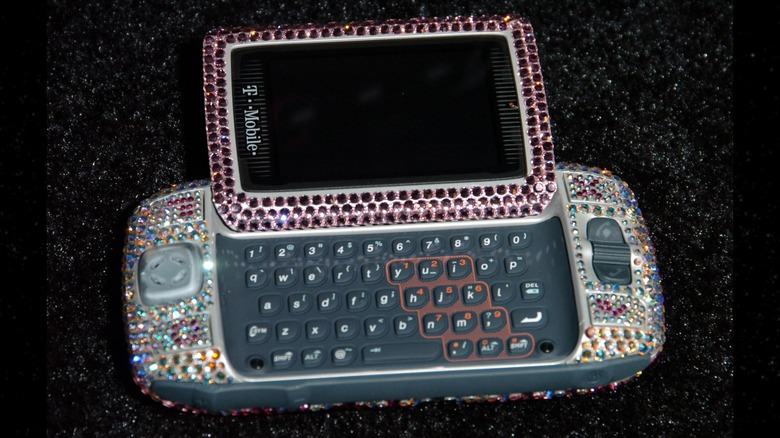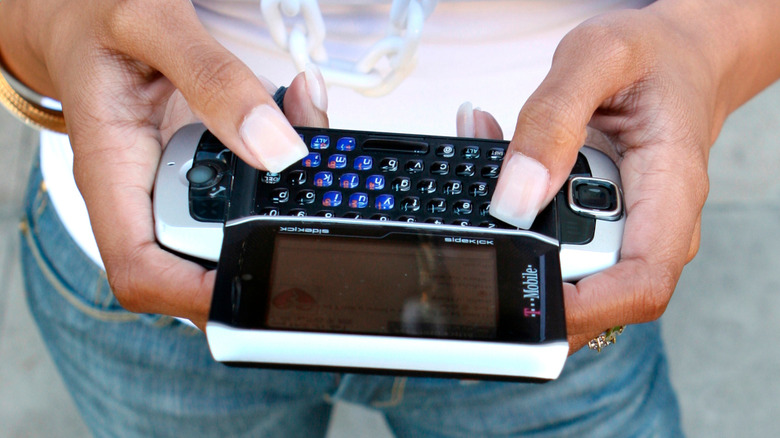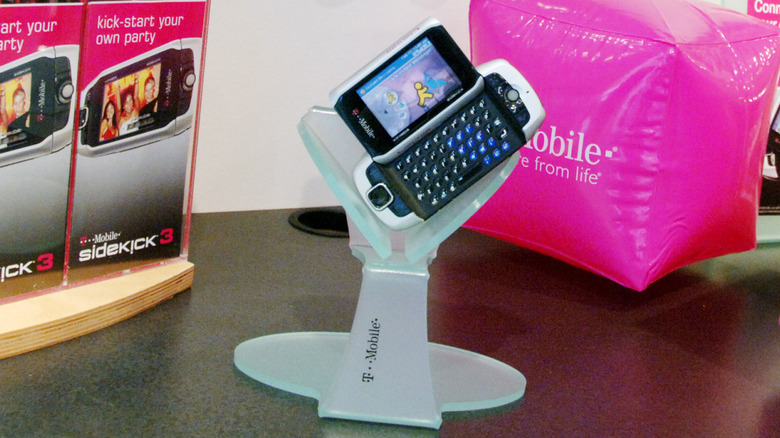What Happened To T-Mobile Sidekick? A Look Back At The Discontinued Hit Of The 2000s
For a while in the 2000s, bizarre phones with quirky styles were all the rage. While trends have started coming back around, perhaps one of the biggest tells that a phone hails from those heady days is if it flips or slides. The second clue that dates a phone is a physical keyboard, especially if it's QWERTY. The T-Mobile Sidekick had both of those features, and it seemed to be everywhere in the 2000s until it suddenly disappeared.
The Sidekick launched in 2002, giving users a tiny slice of the web for their pockets back when the modern smartphone was still a distant glint in the future. Sidekicks plugged their users directly into the instant messaging services of yesteryear, Yahoo!, email inboxes, and general web browsing, all beyond the confines of their homes.
The Sidekick was a collaboration between T-Mobile and Danger Inc. After a few years and models, including ones built by Motorola and Samsung, T-Mobile pulled the plug on the Sidekick in 2012, announcing that the Sidekick 4G would be discontinued just a year following its release. At the time, T-Mobile told The Verge that it wouldn't be the end of the line for the phone's lineage, but no other models came to fruition. Now, the Sidekick is very much a thing of the past, despite the fact that echoes of the device can still be seen in smartphones today.
Data breaches and outages damaged Sidekick's reputation
One of the Sidekick's key features was also its downfall. All Sidekick data — like photos and notes — was kept in the cloud instead of local storage. The data was then associated with private user accounts, making it possible to transfer data between devices simply by logging in. Although convenient, and at the time remarkably high-tech, the security and stability needed to maintain this system weren't there.
A scandal struck in 2005 when a group of hackers used social engineering and a website exploit to access private data from the cloud. Per the Washington Post, the hackers targeted Paris Hilton, who had previously advertised the device. They misled a company phone agent to access her data and leaked her private photographs onto the web in a highly public act of image-based sexual abuse.
Sidekick devices continued to be in vogue for a few years after that, but their cloud issues continued. In 2009, Sidekick users couldn't access their data due to a server failure. It was unclear if the data would be reinstated or lost altogether; Microsoft, which had bought Danger Inc. just the year prior, didn't appear to have backups for user data, and the users' backups essentially were the data lost in the cloud. Naturally, this damaged user trust and even led to lawsuits. T-Mobile even ended up pausing sales of the Sidekick altogether.
Competition likely contributed to the end of the Sidekick
Sidekick finally reached the end of the line in 2012 after T-Mobile discontinued the relatively new Sidekick 4G. At the time, T-Mobile was insistent that it wouldn't be the end for the brand. However, the Sidekick never returned. The closest to a comeback was an April Fool's gag announcing the "Sidekicks Smartshoephone." Naturally, the Bluetooth-enabled phone-sneakers didn't come to fruition.
By the late 2010s, the Sidekick didn't have much of a market as smartphones became more mainstream. The device's features weren't that novel anymore. Phones with similar features were widely available, creating competition. Consumers had different options, which they had reason to choose after Sidekick's data problems. And it wasn't just that these new devices were similar to the once-unique Sidekick. Many of them had features that were perhaps more innovative than what the handheld had to offer.
Apple launched the original iPhone in 2007, a then-unprecedented, internet-enabled touchscreen device. For the rest of the Sidekick's lifespan, a new iPhone came out each year. By 2008, the iPhone had claimed 1.1% of the global mobile phone market, and in 2010, the iPhone 3GS became the most popular cell phone in the United States. This wasn't its only competition, either. BlackBerry was also making waves in mainstream markets with similar keyboard-equipped devices. Even during Sidekick's heyday, the phone's sales were fairly moderate, and it was considered by some to be a cult device. So, once the brand's public image was tarnished and other options became available, it seemed inevitable that the Sidekick would also fall.


